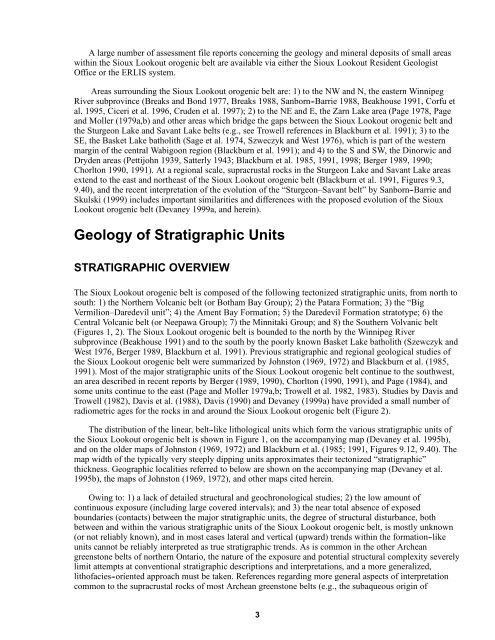Regional Geology, Sioux Lookout Orogenic Belt - Geology Ontario
Regional Geology, Sioux Lookout Orogenic Belt - Geology Ontario
Regional Geology, Sioux Lookout Orogenic Belt - Geology Ontario
You also want an ePaper? Increase the reach of your titles
YUMPU automatically turns print PDFs into web optimized ePapers that Google loves.
A large number of assessment file reports concerning the geology and mineral deposits of small areas<br />
within the <strong>Sioux</strong> <strong>Lookout</strong> orogenic belt are available via either the <strong>Sioux</strong> <strong>Lookout</strong> Resident Geologist<br />
Office or the ERLIS system.<br />
Areas surrounding the <strong>Sioux</strong> <strong>Lookout</strong> orogenic belt are: 1) to the NW and N, the eastern Winnipeg<br />
River subprovince (Breaks and Bond 1977, Breaks 1988, Sanborn--Barrie 1988, Beakhouse 1991, Corfu et<br />
al. 1995, Ciceri et al. 1996, Cruden et al. 1997); 2) to the NE and E, the Zarn Lake area (Page 1978, Page<br />
and Moller (1979a,b) and other areas which bridge the gaps between the <strong>Sioux</strong> <strong>Lookout</strong> orogenic belt and<br />
the Sturgeon Lake and Savant Lake belts (e.g., see Trowell references in Blackburn et al. 1991); 3) to the<br />
SE, the Basket Lake batholith (Sage et al. 1974, Szweczyk and West 1976), which is part of the western<br />
margin of the central Wabigoon region (Blackburn et al. 1991); and 4) to the S and SW, the Dinorwic and<br />
Dryden areas (Pettijohn 1939, Satterly 1943; Blackburn et al. 1985, 1991, 1998; Berger 1989, 1990;<br />
Chorlton 1990, 1991). At a regional scale, supracrustal rocks in the Sturgeon Lake and Savant Lake areas<br />
extend to the east and northeast of the <strong>Sioux</strong> <strong>Lookout</strong> orogenic belt (Blackburn et al. 1991, Figures 9.3,<br />
9.40), and the recent interpretation of the evolution of the “Sturgeon–Savant belt” by Sanborn--Barrie and<br />
Skulski (1999) includes important similarities and differences with the proposed evolution of the <strong>Sioux</strong><br />
<strong>Lookout</strong> orogenic belt (Devaney 1999a, and herein).<br />
<strong>Geology</strong> of Stratigraphic Units<br />
STRATIGRAPHIC OVERVIEW<br />
The <strong>Sioux</strong> <strong>Lookout</strong> orogenic belt is composed of the following tectonized stratigraphic units, from north to<br />
south: 1) the Northern Volcanic belt (or Botham Bay Group); 2) the Patara Formation; 3) the “Big<br />
Vermilion–Daredevil unit”; 4) the Ament Bay Formation; 5) the Daredevil Formation stratotype; 6) the<br />
Central Volcanic belt (or Neepawa Group); 7) the Minnitaki Group; and 8) the Southern Volvanic belt<br />
(Figures 1, 2). The <strong>Sioux</strong> <strong>Lookout</strong> orogenic belt is bounded to the north by the Winnipeg River<br />
subprovince (Beakhouse 1991) and to the south by the poorly known Basket Lake batholith (Szewczyk and<br />
West 1976, Berger 1989, Blackburn et al. 1991). Previous stratigraphic and regional geological studies of<br />
the <strong>Sioux</strong> <strong>Lookout</strong> orogenic belt were summarized by Johnston (1969, 1972) and Blackburn et al. (1985,<br />
1991). Most of the major stratigraphic units of the <strong>Sioux</strong> <strong>Lookout</strong> orogenic belt continue to the southwest,<br />
an area described in recent reports by Berger (1989, 1990), Chorlton (1990, 1991), and Page (1984), and<br />
some units continue to the east (Page and Moller 1979a,b; Trowell et al. 1982, 1983). Studies by Davis and<br />
Trowell (1982), Davis et al. (1988), Davis (1990) and Devaney (1999a) have provided a small number of<br />
radiometric ages for the rocks in and around the <strong>Sioux</strong> <strong>Lookout</strong> orogenic belt (Figure 2).<br />
The distribution of the linear, belt--like lithological units which form the various stratigraphic units of<br />
the <strong>Sioux</strong> <strong>Lookout</strong> orogenic belt is shown in Figure 1, on the accompanying map (Devaney et al. 1995b),<br />
and on the older maps of Johnston (1969, 1972) and Blackburn et al. (1985; 1991, Figures 9.12, 9.40). The<br />
map width of the typically very steeply dipping units approximates their tectonized “stratigraphic”<br />
thickness. Geographic localities referred to below are shown on the accompanying map (Devaney et al.<br />
1995b), the maps of Johnston (1969, 1972), and other maps cited herein.<br />
Owing to: 1) a lack of detailed structural and geochronological studies; 2) the low amount of<br />
continuous exposure (including large covered intervals); and 3) the near total absence of exposed<br />
boundaries (contacts) between the major stratigraphic units, the degree of structural disturbance, both<br />
between and within the various stratigraphic units of the <strong>Sioux</strong> <strong>Lookout</strong> orogenic belt, is mostly unknown<br />
(or not reliably known), and in most cases lateral and vertical (upward) trends within the formation--like<br />
units cannot be reliably interpreted as true stratigraphic trends. As is common in the other Archean<br />
greenstone belts of northern <strong>Ontario</strong>, the nature of the exposure and potential structural complexity severely<br />
limit attempts at conventional stratigraphic descriptions and interpretations, and a more generalized,<br />
lithofacies--oriented approach must be taken. References regarding more general aspects of interpretation<br />
common to the supracrustal rocks of most Archean greenstone belts (e.g., the subaqueous origin of<br />
3

















